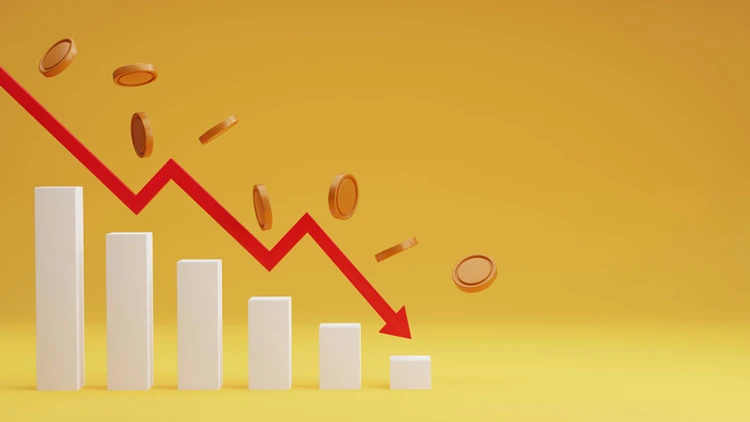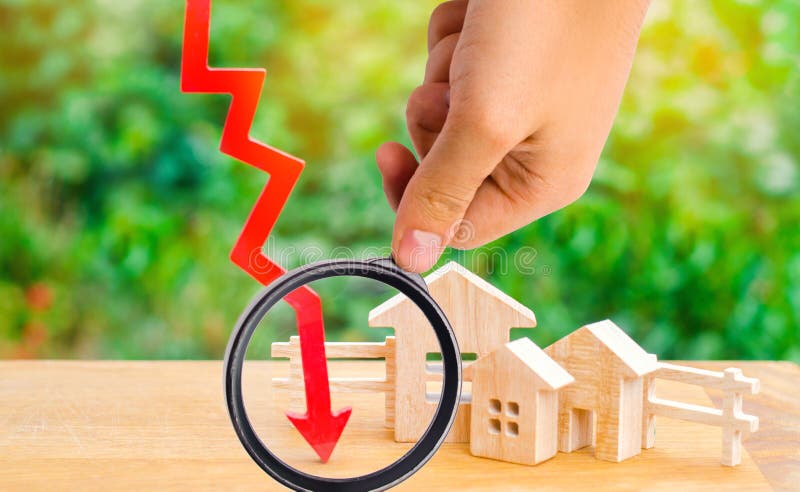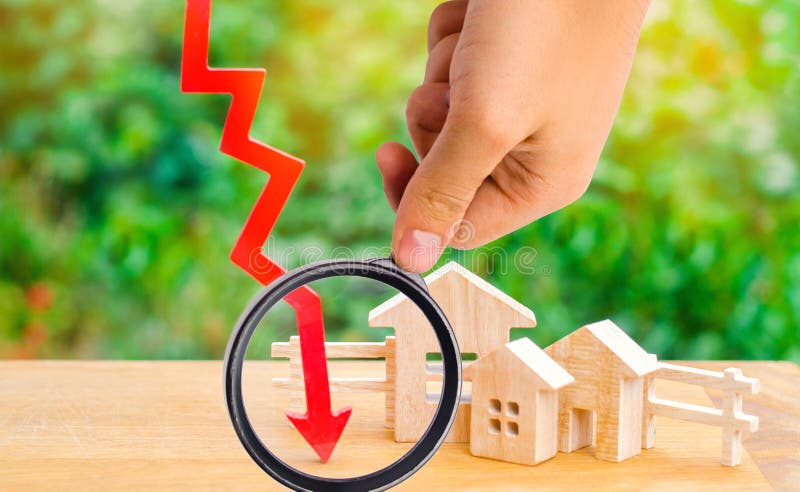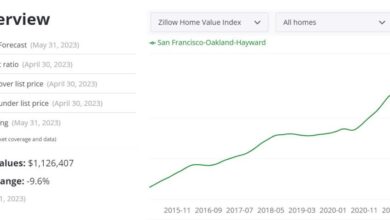Falling Rates Bad News for the Housing Market
Why falling mortgage rates can signal bad news. A seemingly positive trend—lower monthly payments—might actually mask deeper economic problems. This dive into the intricate relationship between mortgage rates and broader economic indicators reveals how a decrease in borrowing costs can sometimes be a harbinger of trouble. From consumer behavior to market saturation and the responses of financial institutions, we’ll explore the various facets of this complex issue.
Prepare to uncover the hidden signals that falling rates might be sending.
This analysis examines how falling mortgage rates, while seemingly beneficial for homebuyers, can often indicate underlying economic weaknesses. We’ll explore historical data, consumer behavior, market trends, and the responses of financial institutions to understand why these lower rates might not always be good news.
Economic Indicators Tied to Mortgage Rates
Falling mortgage rates can sometimes be a positive sign, indicating a cooling housing market or a potential easing of economic pressures. However, a closer look at the correlated economic indicators often reveals a more complex picture. Sometimes, these seemingly favorable trends mask underlying economic weakness, potentially foreshadowing a larger downturn. This article delves into the indicators tied to mortgage rates and examines how they can signal potential trouble.Understanding the interplay between mortgage rates and broader economic indicators is crucial for assessing the health of the economy.
The relationship is not always straightforward, but consistent patterns often emerge, offering valuable insights for informed decision-making.
Key Economic Indicators Correlated with Mortgage Rates
Mortgage rates are influenced by a multitude of economic factors, including inflation, unemployment, and GDP growth. These factors often move in tandem, providing clues about the overall economic climate. A significant drop in mortgage rates, while seemingly positive, can be a warning sign if it’s not accompanied by corresponding improvements in other economic metrics.
- Inflation: High inflation often leads to higher interest rates, including mortgage rates, as lenders demand higher returns to compensate for the eroding purchasing power of money. Conversely, falling inflation can lead to lower mortgage rates. However, a sustained period of falling inflation can sometimes precede a period of economic stagnation, signaling a potential decline in overall economic activity.
- Unemployment Rate: A strong economy usually correlates with a low unemployment rate. Falling mortgage rates, accompanied by a rising unemployment rate, might indicate a weakening economy where consumers are less likely to take on debt for major purchases like homes. A decline in consumer spending, in turn, could negatively affect economic growth.
- Gross Domestic Product (GDP) Growth: A healthy economy is typically associated with positive GDP growth. Falling mortgage rates, coupled with slowing GDP growth, could suggest a potential economic downturn. A decrease in economic activity may be less visible initially, but can later lead to a broader economic slowdown.
- Consumer Confidence: Consumer confidence is a key indicator of spending habits and future expectations. A significant decline in consumer confidence, despite falling mortgage rates, could suggest underlying economic concerns that are not yet reflected in other indicators. Lower confidence can lead to reduced consumer spending and hinder economic growth.
Historical Relationship Between Mortgage Rates and Economic Trends
Examining past trends in mortgage rates and economic indicators reveals a complex relationship. Historical data demonstrates a recurring pattern where falling mortgage rates have sometimes preceded economic downturns. This doesn’t mean every decline in rates precedes a recession, but it’s a signal to look at the bigger picture.
Examples of Past Instances Where Falling Rates Preceded Downturns
While a precise prediction isn’t possible, historical analysis offers valuable context. For instance, the period leading up to the 2008 financial crisis saw falling mortgage rates, yet the housing market experienced a significant bubble, ultimately leading to a major recession. Similarly, other periods of declining mortgage rates, paired with weakening economic indicators, have been followed by economic downturns. These instances highlight the importance of considering the overall economic picture when evaluating mortgage rate trends.
Comparison of Mortgage Rates with Key Economic Indicators (2010-2023)
| Year | Mortgage Rate (Average) | Unemployment Rate (%) | GDP Growth (%) | Inflation Rate (%) |
|---|---|---|---|---|
| 2010 | 4.5% | 9.6 | 2.5 | 1.6 |
| 2015 | 4.0% | 5.3 | 2.3 | 0.1 |
| 2020 | 3.1% | 14.7 | -3.5 | 1.4 |
| 2023 | 6.5% | 3.5 | 0.1 | 4.5 |
Note: This table provides a simplified representation. More comprehensive data and analysis are available from reliable sources like the Federal Reserve and the Bureau of Economic Analysis.
Consumer Behavior and Falling Rates

Falling mortgage rates often evoke images of a vibrant housing market, but a deeper dive reveals a more nuanced picture. While lower rates can stimulate borrowing, they can also signal underlying economic anxieties. Consumers’ reactions to falling rates are complex and influenced by a multitude of factors, including their overall financial health and confidence in the future. This intricate interplay can have significant ripple effects throughout the broader economy, impacting not only the housing sector but also related industries.Falling mortgage rates can lead to a range of consumer behaviors, potentially boosting housing market activity.
However, the extent and nature of this impact depend heavily on consumer confidence and the broader economic climate. If consumers anticipate further rate declines or perceive a stable economic outlook, they might be more inclined to purchase homes. Conversely, if concerns persist about job security, inflation, or broader economic instability, even attractive mortgage rates may not encourage significant buying activity.
Consumer Reactions to Falling Rates
Consumers often respond to falling mortgage rates with a mix of excitement and cautious consideration. They weigh the benefits of lower monthly payments against the potential risks of a declining housing market or a slowing economy. For example, during the 2008 financial crisis, initial enthusiasm about falling rates was quickly overshadowed by anxieties about the overall market stability.
Factors Influencing Consumer Confidence
Consumer confidence plays a critical role in borrowing decisions. Factors such as job market conditions, inflation expectations, and general economic forecasts significantly impact consumer willingness to take on mortgage debt. A robust job market and low inflation typically bolster confidence, encouraging home purchases. Conversely, high unemployment or rising inflation can deter borrowing and dampen housing market activity.
Falling mortgage rates, while seemingly good for homebuyers, can sometimes signal a weakening economy. This is especially true when considering the current state of the San Jose hotel economy, property market, tech build-out, and job situation following the pandemic, as highlighted in this article about San Jose’s hotel economy, property tech build, COVID impact, NVIDIA jobs, and overall work situation.
Reduced demand for housing, or even a slowdown in the tech sector, could lead to a drop in mortgage rates, which ultimately points to a potentially struggling economy, regardless of the individual buyer’s situation.
For example, recent data from the Conference Board’s Consumer Confidence Index often shows correlations with mortgage rate fluctuations.
Impact on Related Sectors
A decrease in borrowing activity, whether driven by cautious consumers or other economic factors, can have consequences for related sectors like construction and real estate. Reduced demand for new homes or refinancing can lead to lower construction activity and decreased profitability for builders. Similarly, real estate agents and related service providers might experience decreased business volume.
Comparison with Previous Periods of Declining Rates
Comparing consumer behavior during previous periods of declining mortgage rates provides valuable insights. Analyzing data from the 1990s and 2000s shows how changing economic conditions influenced consumer decisions. While lower rates often stimulate demand, other economic factors, such as job growth or inflation, play equally important roles. For instance, the housing boom of the early 2000s, fueled by falling rates, was eventually tempered by unsustainable lending practices and a burst of the housing bubble.
Consumer Sentiment and Housing Market Activity During Falling Rates
| Period | Consumer Sentiment | Housing Market Activity |
|---|---|---|
| Early 1990s | Positive, fueled by a strong economy | Significant increase in home purchases |
| Early 2000s | High, influenced by low interest rates and optimism | Rapid housing market growth, leading to a bubble |
| 2008-2009 | Negative, due to the financial crisis | Significant decline in home purchases |
| Recent Periods (e.g., 2020-2023) | Mixed, influenced by inflation and supply chain issues | Moderated growth, affected by factors beyond interest rates |
This table illustrates the varied responses to falling mortgage rates, highlighting the complex interplay between consumer confidence, economic factors, and housing market activity. Understanding these patterns can provide valuable insights for predicting future trends.
Market Saturation and Overheating
Falling mortgage rates can sometimes fuel a housing market frenzy, leading to a dangerous cycle of overvaluation and instability. This surge in demand, often driven by affordability, can push prices beyond sustainable levels, creating a bubble that eventually bursts. Understanding the dynamics of market saturation and overheating is crucial for anyone navigating the housing market, whether as a buyer, seller, or investor.
The Concept of Market Saturation and Overheating
Market saturation in the housing market occurs when the supply of available homes is insufficient to meet the current demand. This imbalance, often exacerbated by low interest rates, drives prices upward. Overheating is a more severe form of this, where demand significantly outstrips supply, and prices escalate rapidly, detached from fundamental values. The housing market becomes extremely volatile, and the potential for a sharp correction becomes substantial.
This is frequently accompanied by an increase in risky lending practices and an overextension of credit.
How Falling Mortgage Rates Contribute to Saturation and Overheating
Falling mortgage rates make homes more affordable, attracting more buyers into the market. This increased demand, combined with limited supply, pushes prices upward. When rates are consistently low for an extended period, it can fuel a speculative market where buyers aren’t necessarily focused on long-term value but on the short-term potential for price appreciation. This is a prime driver of saturation and overheating.
The cycle intensifies when more investors enter the market, further increasing demand and driving up prices.
Examples of Housing Markets Experiencing Saturation or Overheating
Numerous historical examples illustrate the phenomenon of housing market saturation and overheating. The housing bubble in the mid-2000s, driven in part by low mortgage rates and aggressive lending practices, is a stark example. Other regions and periods have witnessed similar trends. The recent rapid increase in prices in some urban areas, correlated with historically low interest rates, also highlight this risk.
Understanding the specific characteristics of these markets, including the rate of price increase and the degree of investor activity, can provide valuable insights.
Potential Consequences for the Broader Economy
Market saturation and overheating in the housing market can have significant repercussions for the broader economy. A sharp correction, often triggered by rising interest rates or a decrease in investor confidence, can lead to a significant economic downturn. Increased foreclosure rates, a reduction in consumer spending, and instability in financial markets are all potential outcomes. The fallout can be substantial, affecting not only homeowners but also businesses and the overall economic stability.
Comparison of Healthy vs. Saturated Housing Markets
| Characteristic | Healthy Housing Market | Saturated/Overheating Housing Market |
|---|---|---|
| Mortgage Rate Trend | Stable, or gradually rising, reflecting underlying economic conditions. | Consistently low, potentially artificially low, driving rapid price increases. |
| Supply and Demand | Balanced, with sufficient inventory to meet demand. | Significant imbalance; demand far outstrips supply. |
| Price Appreciation Rate | Moderate, aligned with inflation and economic growth. | Rapid and unsustainable price appreciation, often exceeding inflation. |
| Investor Activity | Limited to institutional investors and long-term buyers. | Significant investor involvement, potentially speculators, leading to increased price volatility. |
| Lending Practices | Rigorous and prudent. | More aggressive and potentially risky lending practices. |
Financial Institution Responses
Falling mortgage rates, while seemingly beneficial for borrowers, can present significant challenges for financial institutions. These institutions hold substantial portfolios of mortgage-backed securities and make loans directly to borrowers. Understanding how they respond to falling rates is crucial for evaluating the overall health of the market. The ripple effects of these responses can influence the availability and terms of mortgages for future borrowers.
Falling mortgage rates, while seemingly good for buyers, can actually be a warning sign of economic trouble. A significant drop often indicates a slowing economy, which might be linked to a rise in unintended pregnancies, prompting women to seek options like those detailed in this article about abortions being up in the US, it’s a complicated picture as women turn to pills travel abortions are up in the us its a complicated picture as women turn to pills travel.
Ultimately, a drop in rates could be a sign that the market is anticipating a recession, making it a less desirable investment. So, while lower rates might look tempting, it’s wise to consider the bigger picture before making any major decisions.
Potential Responses of Financial Institutions
Financial institutions employ various strategies to manage the risks associated with falling mortgage rates. These strategies aim to protect their profitability and maintain the stability of their loan portfolios. Often, they adjust pricing models, modify lending policies, and potentially re-evaluate their investment strategies. They also monitor the overall market conditions and the impact on their portfolio value.
The specifics of their response will depend on the institution’s individual circumstances, such as the size of its mortgage portfolio and the composition of its assets.
Falling mortgage rates, while tempting for homebuyers, can sometimes be a red flag. It might suggest a struggling housing market, and if you’re looking for ways to bolster your security, exploring the best ptz security cameras here could be a smart move. Ultimately, falling rates often mean there’s less demand, potentially pointing to broader economic issues and, unfortunately, a less secure financial future.
Strategies to Mitigate Risks
Institutions may implement several strategies to mitigate the risks associated with falling mortgage rates. These strategies are designed to minimize losses and maintain profitability.
- Adjusting Pricing Models: Financial institutions might adjust their pricing models for new mortgages to compensate for lower interest rates. This could involve offering more competitive rates to attract borrowers or increasing fees and points to maintain profit margins. For instance, if the prevailing rate falls significantly, an institution might offer lower rates but increase closing costs or origination fees to balance their income.
- Modifying Lending Policies: Institutions may modify lending policies to reduce risk exposure. This might include stricter underwriting standards, requiring larger down payments, or increasing the loan-to-value ratios. This is done to ensure that borrowers can still afford their mortgage payments even with lower rates, protecting the institution from potential default. A more stringent lending policy may reduce the number of loans granted but can minimize the chance of default.
- Re-evaluating Investment Strategies: Institutions may need to re-evaluate their investment strategies. This could involve shifting their portfolio towards assets that are less sensitive to falling interest rates or hedging their exposure to rate fluctuations. For example, they may invest more in longer-term bonds to counter the impact of falling short-term rates.
Consequences for Mortgage Availability and Lending Conditions
The responses of financial institutions can have a significant impact on the availability and terms of mortgages. Falling rates can create increased competition among lenders, leading to more favorable terms for borrowers. However, stricter lending policies and adjustments to pricing models might result in decreased mortgage availability. For example, tighter underwriting standards can make it more difficult for some borrowers to qualify for a mortgage.
Impact on Profitability
Falling mortgage rates can negatively affect the profitability of financial institutions. This is because the yield on their existing mortgage-backed securities decreases, reducing the return on investment. The strategies to mitigate these risks, such as adjusting pricing models, might also reduce the overall profit margin. This pressure often leads to increased scrutiny on the overall efficiency of lending practices.
For instance, if interest rates decline sharply, the yield on existing mortgages decreases, potentially leading to a decrease in profitability for the institution.
Table: Strategies of Financial Institutions During Previous Periods of Falling Mortgage Rates
| Institution Type | Strategy 1 | Strategy 2 | Strategy 3 |
|---|---|---|---|
| Large Banks | Adjusted pricing models for new mortgages, offering lower rates | Increased scrutiny of loan applications and stricter underwriting guidelines | Diversified investments to hedge against rate fluctuations |
| Mortgage Companies | Focused on attracting borrowers through competitive rates | Implemented new incentive programs for loan origination | Increased origination fees or points |
| Credit Unions | Maintained competitive rates while implementing lower fees | Increased member education and financial counseling services | Improved risk assessment methodologies for borrowers |
Global Economic Context

Falling mortgage rates, while often seen as a positive sign for consumers, can sometimes be a warning bell, especially when viewed through the lens of global economic conditions. A decline in rates might not always stem from healthy domestic factors, but rather reflect broader global anxieties. Understanding the interconnectedness of international markets is crucial to interpreting the true meaning behind falling mortgage rates.The global economy acts as a powerful force, influencing interest rates and ultimately, the cost of borrowing.
Economic downturns in major economies, shifts in global supply chains, or anxieties about geopolitical instability can all impact the domestic interest rate landscape. This ripple effect is particularly evident in the mortgage market, where a global trend can quickly manifest as a change in local borrowing costs.
The Role of Global Economic Conditions
Global economic conditions, including trends in inflation, growth rates, and interest rates in other major economies, play a significant role in determining domestic mortgage rates. When global economic uncertainty increases, central banks in other countries might raise interest rates to combat inflation or potential downturns. This action often triggers a similar response from domestic central banks, impacting mortgage rates as well.
Impact of International Events
International events can significantly affect domestic mortgage rates. A major political crisis in a significant global economy can cause investors to seek safer havens, leading to a flight to quality. This often translates to increased demand for U.S. Treasury bonds, pushing down their yields, and consequently, influencing mortgage rates. Similarly, significant shifts in global supply chains, like those triggered by geopolitical tensions, can disrupt the flow of goods and services, impacting inflation and ultimately, interest rates.
Potential Negative Indicators
Several global factors can signal a potential negative indicator when mortgage rates fall. For instance, a significant global recession, marked by declining economic activity and high unemployment in major economies, could be a hidden driver of falling rates. This could be a symptom of an underlying economic weakness rather than a sign of strength. A widespread decline in global investment, driven by fear or uncertainty, could also manifest in falling mortgage rates, reflecting a lack of confidence in the global economic outlook.
Examples of Past Impacts
The 2008 global financial crisis serves as a stark example of how global events can impact domestic mortgage rates. The crisis, triggered by a collapse in the U.S. housing market, quickly spread globally, leading to a sharp decline in economic activity and a significant drop in interest rates. While the fall in rates initially appeared positive, it was ultimately a symptom of a larger, more complex global economic crisis.
Similarly, the Eurozone debt crisis of the late 2000s and early 2010s influenced global financial markets and, consequently, mortgage rates in the U.S.
Interconnectivity of Global and Domestic Economies, Why falling mortgage rates can signal bad news
The modern global economy is highly interconnected. Events in one part of the world can have profound effects on economies elsewhere. This interconnectivity directly influences mortgage rates. For example, a slowdown in Chinese economic growth could impact global supply chains and raw material prices, influencing inflation and ultimately, interest rates. The interconnectedness means that domestic economic health is inextricably linked to global economic performance.
This makes understanding the global context crucial for accurately interpreting the implications of falling mortgage rates.
Illustrative Case Studies
Falling mortgage rates, while often associated with positive economic signals, can sometimes be a warning sign of underlying problems. A historical perspective reveals instances where seemingly favorable rates masked deeper economic vulnerabilities. These periods highlight the intricate relationship between monetary policy, consumer behavior, and market health. Examining these case studies can provide valuable insights into the nuanced interpretation of mortgage rate trends.
The Housing Bubble of 2008
The housing bubble of 2008 serves as a stark example of how falling mortgage rates can be a symptom of a precarious market. Low interest rates fueled a surge in housing demand, leading to rapid price appreciation. Subprime mortgages, offered to borrowers with questionable creditworthiness, further exacerbated the situation. This influx of readily available credit, although appearing beneficial in the short term, created a highly inflated housing market.
- Economic Conditions: Low interest rates combined with lax lending standards fostered a housing boom. Subprime lending practices, aimed at increasing market share, were key factors.
- Consumer Behavior: Low mortgage rates and easy credit access incentivized consumers to borrow heavily, leading to overleveraged households. A false sense of security emerged, masking the risks inherent in the situation.
- Market Responses: The market responded with increased construction activity and a surge in home prices. This created a positive feedback loop that obscured the underlying fragility.
The rapid price increases masked the fact that many homes were being purchased above their intrinsic value. The lack of sufficient scrutiny regarding the risk profiles of these loans and the absence of robust oversight contributed to the collapse of the market. This example clearly demonstrates the dangerous consequences of overly optimistic market readings, fueled by seemingly beneficial economic indicators.
| Event | Indicator | Impact |
|---|---|---|
| Low mortgage rates | Increased demand, rapid price appreciation | Masking underlying market instability |
| Subprime lending | Increased borrowing capacity, inflated values | Fueled a speculative bubble |
| Lack of regulatory oversight | Insufficient scrutiny of loans | Led to unsustainable market growth |
| Housing market crash | Significant price declines, widespread foreclosures | Severe economic downturn |
Closing Summary: Why Falling Mortgage Rates Can Signal Bad News
In conclusion, the relationship between falling mortgage rates and economic health is multifaceted and nuanced. While lower rates can stimulate the housing market in the short term, they can also signal deeper economic problems, impacting consumer behavior, market saturation, and financial institutions. This article has explored the various factors at play, demonstrating that a seemingly simple trend can have far-reaching consequences.
Understanding these interconnected elements is crucial for navigating the complexities of the housing market and the broader economy.



